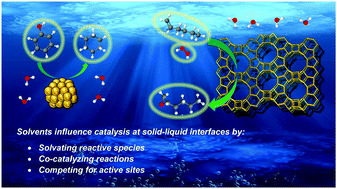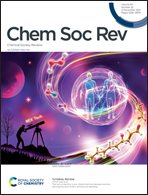Influence of solvent structure and hydrogen bonding on catalysis at solid–liquid interfaces
Abstract
Solvent molecules interact with reactive species and alter the rates and selectivities of catalytic reactions by orders of magnitude. Specifically, solvent molecules can modify the free energies of liquid phase and surface species via solvation, participating directly as a reactant or co-catalyst, or competitively binding to active sites. These effects carry consequences for reactions relevant for the conversion of renewable or recyclable feedstocks, the development of distributed chemical manufacturing, and the utilization of renewable energy to drive chemical reactions. First, we describe the quantitative impact of these effects on steady-state catalytic turnover rates through a rate expression derived for a generic catalytic reaction (A → B), which illustrates the functional dependence of rates on each category of solvent interaction. Second, we connect these concepts to recent investigations of the effects of solvents on catalysis to show how interactions between solvent and reactant molecules at solid–liquid interfaces influence catalytic reactions. This discussion demonstrates that the design of effective liquid phase catalytic processes benefits from a clear understanding of these intermolecular interactions and their implications for rates and selectivities.



 Please wait while we load your content...
Please wait while we load your content...